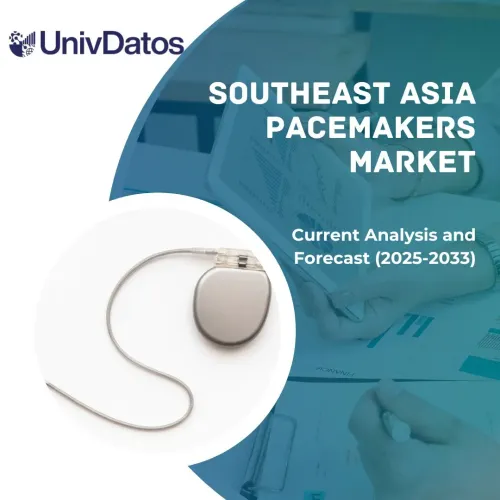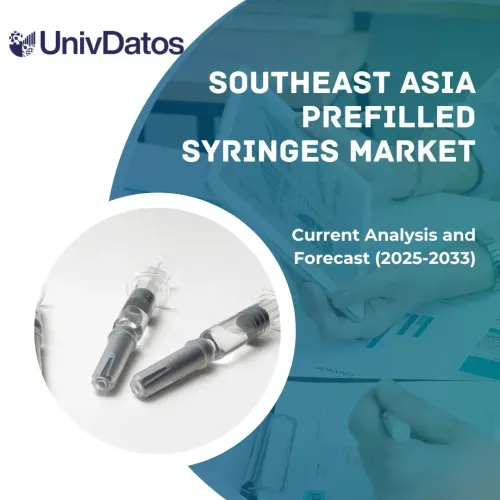- Home
- About Us
- Industry
- Services
- Reading
- Contact Us
Diabetic Retinopathy Market: Current Analysis and Forecast (2023-2030)
Emphasis on Types (Proliferative Diabetic Retinopathy and Non-Proliferative Diabetic Retinopathy); Application (Diagnosis and Treatment); Region/Country
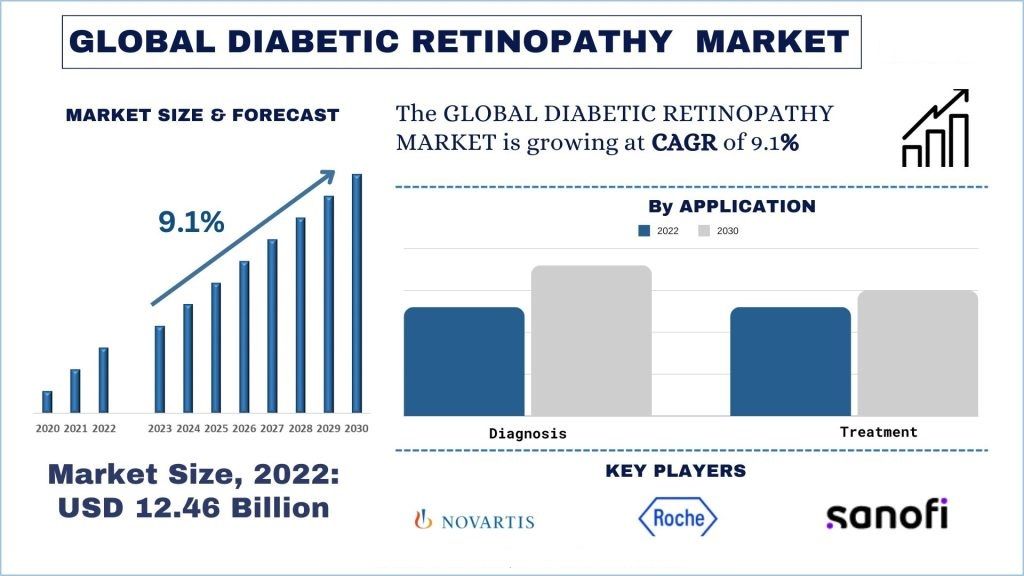
Diabetic Retinopathy Market Size & Forecast
The Diabetic Retinopathy Device Market was valued at USD 12,467.68 Million in 2022 and is expected to grow at a strong CAGR of around 9.1% during the forecast period (2023-2030) owing to the rising cases of diabetic retinopathy.
Diabetic Retinopathy Market Analysis
For instance, according to the U.S. Department of Health & Human Services, in 2021 across all ages, an estimated 9.6 million people in the U.S. were living with diabetic retinopathy. Among these, 1.84 million were living with vision-threatening diabetic retinopathy. Diabetic retinopathy is a diabetes-related complication that affects the eyes. It occurs when high blood sugar levels damage the blood vessels in the retina, the light-sensitive tissue at the back of the eye. The rising cases of diabetes, high blood pressure, elevated cholesterol levels, smoking, and family history are considered driving factors for the diabetic retinopathy market and are propelling the market to a new extent.
Some of the major players operating in the market F. Hoffmann-La Roche Ltd; Novartis AG; Regeneron Pharmaceuticals Inc.; Bayer AG; Coherus BioSciences, Inc.; KODIAK SCIENCES INC.; HANLIM PHARM.CO.LTD.; Sanofi; Intas Pharmaceuticals Ltd.; Sun Pharmaceutical Industries Ltd. Several M&As along with partnerships have been undertaken by these players to facilitate customers with hi-tech and innovative products/technologies.
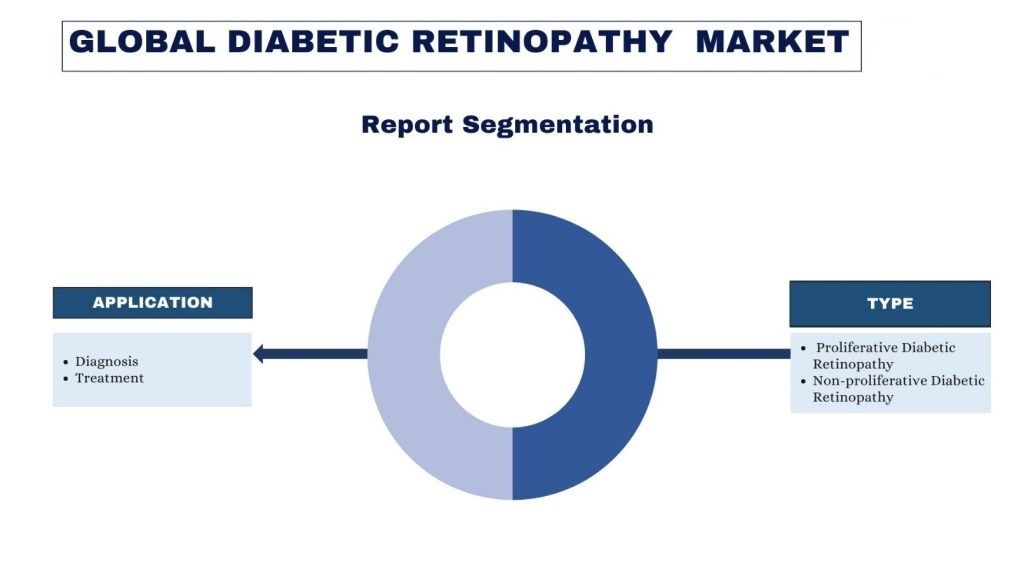
Diabetic Retinopathy Market Trends
“Amongst types, the non-proliferative diabetic retinopathy category to grow with high CAGR during the forecast period”
Based on types, the market is bifurcated into proliferative diabetic retinopathy and non-proliferative diabetic retinopathy. The non-proliferative diabetic retinopathy is growing at a steady rate owing to the growing cases of diabetes. Non-proliferative diabetic retinopathy, also known as background retinopathy, is an early stage of diabetic retinopathy. In non-proliferative diabetic retinopathy, the small blood vessels in the retina are damaged due to prolonged exposure to high levels of blood sugar. Rising cases of diabetes are leading to potential growth in this segment. Thus, the non-proliferative diabetic retinopathy category is expected to grow with a high CAGR during the forecast period.
“Amongst applications, the treatment segment held a significant share in the year 2022”
Based on applications, the market is segmented into diagnosis and treatment. The treatment is growing at a steady rate owing to the multiple ongoing clinical trials. For instance, in July 2023, Third Affiliated Hospital, Sun Yat-Sen University initiated a study, of three different glucose-lowering programs for comparison to focus on the stability and the impact of these three programs’ hypoglycemic long-term prognosis of diabetic retinopathy. The treatment segment in the diabetic retinopathy market involves techniques like anti-VEGF drugs, laser therapy, and others. The other driving factor for the segment is the growing incidences of diabetes in the geriatric population. The geriatric population segment represents a significant market for diabetic retinopathy, emphasizing the importance of addressing the unique needs and considerations of older individuals. Thus, the treatment segment held a significant share of the market in the year 2022.

“Amongst regions, APAC region is expected to grow with high CAGR during the forecast period”
APAC is expected to grow with the highest CAGR during the forecast period. The growing number of pharmaceutical industries in Asia-Pacific contributes to the growth of the market in this region. Also, the increasing prevalence of diabetic retinopathy and the rising geriatric population are contributing to the demand for diabetic retinopathy. The large population size of countries in APAC including China and India is majorly responsible for the growth of this market in the region. For instance, according to the IDF Diabetes Atlas, China (140.9 million), India (74.2 million), and Pakistan (33.0 million) had the highest number of diabetics in 2021. In 2045, China (174.4 million) and India (124.9 million) are expected to retain the top spots of countries with the greatest number of people suffering from the disease. Hence, given the large population size of APAC, it is expected to grow with a high CAGR during the forecast period.
Diabetic Retinopathy Market Report Coverage
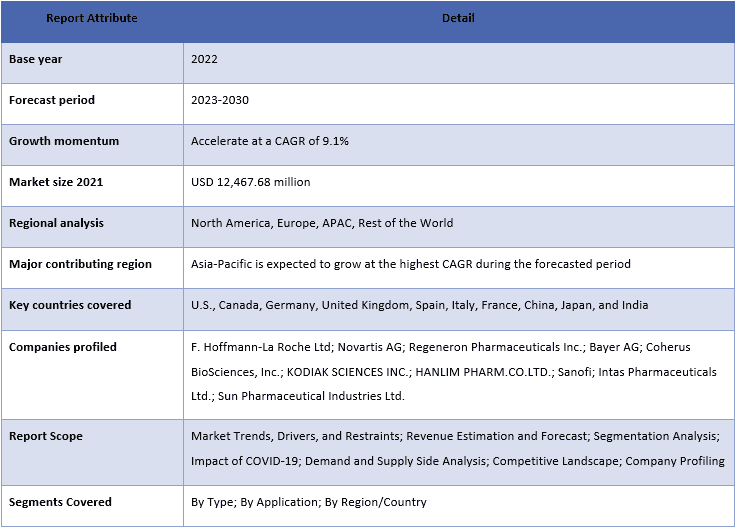
Reasons to buy this report:
- The study includes market sizing and forecasting analysis validated by authenticated key industry experts.
- The report presents a quick review of overall industry performance at one glance.
- The report covers an in-depth analysis of prominent industry peers with a primary focus on key business financials, product portfolios, expansion strategies, and recent developments.
- Detailed examination of drivers, restraints, key trends, and opportunities prevailing in the industry.
- The study comprehensively covers the market across different segments.
- Deep dive regional level analysis of the industry.
Customization Options:
The Global Diabetic Retinopathy Device Market can further be customized as per the requirement or any other market segment. Besides this, UMI understands that you may have your own business needs, hence feel free to connect with us to get a report that completely suits your requirements.
Table of Content
Research Methodology for the Diabetic Retinopathy Market Analysis (2023-2030)
Analyzing the historical market, estimating the current market, and forecasting the future market of the global diabetic retinopathy market were the three major steps undertaken to create and analyze the adoption of diabetic retinopathy in major regions globally. Exhaustive secondary research was conducted to collect the historical market numbers and estimate the current market size. Secondly, to validate these insights, numerous findings and assumptions were taken into consideration. Moreover, exhaustive primary interviews were also conducted, with industry experts across the value chain of the global diabetic retinopathy device market. Post assumption and validation of market numbers through primary interviews, we employed a top-down/bottom-up approach to forecasting the complete market size. Thereafter, market breakdown and data triangulation methods were adopted to estimate and analyze the market size of segments and sub-segments of the industry pertains to. Detailed methodology is explained below:
Analysis of Historical Market Size
Step 1: In-Depth Study of Secondary Sources:
A detailed secondary study was conducted to obtain the historical market size of the diabetic retinopathy device market through company internal sources such as annual reports & financial statements, performance presentations, press releases, etc., and external sources including journals, news & articles, government publications, competitor publications, sector reports, third-party database, and other credible publications.
Step 2: Market Segmentation:
After obtaining the historical market size of the diabetic retinopathy device market, we conducted a detailed secondary analysis to gather historical market insights and share for different segments & sub-segments for major regions. Major segments are included in the report as type, application, and region. Further country-level analyses were conducted to evaluate the overall adoption of testing models in that region.
Step 3: Factor Analysis:
After acquiring the historical market size of different segments and sub-segments, we conducted a detailed factor analysis to estimate the current market size of the diabetic retinopathy device market. Further, we conducted factor analysis using dependent and independent variables such as type, application, and region of the diabetic retinopathy device market. A thorough analysis was conducted for demand and supply-side scenarios considering top partnerships, mergers and acquisitions, business expansion, and product launches in the diabetic retinopathy device market sector across the globe.
Current Market Size Estimate & Forecast
Current Market Sizing: Based on actionable insights from the above 3 steps, we arrived at the current market size, key players in the global diabetic retinopathy device market, and market shares of the segments. All the required percentage shares split and market breakdowns were determined using the above-mentioned secondary approach and were verified through primary interviews.
Estimation & Forecasting: For market estimation and forecast, weights were assigned to different factors including drivers & trends, restraints, and opportunities available for the stakeholders. After analyzing these factors, relevant forecasting techniques i.e., the top-down/bottom-up approach were applied to arrive at the market forecast for 2030 for different segments and sub-segments across the major markets globally. The research methodology adopted to estimate the market size encompasses:
- The industry’s market size, in terms of revenue (USD) and the adoption rate of the diabetic retinopathy device market across the major markets domestically
- All percentage shares, splits, and breakdowns of market segments and sub-segments
- Key players in the global diabetic retinopathy device market in terms of products offered. Also, the growth strategies adopted by these players to compete in the fast-growing market
Market Size and Share Validation
Primary Research: In-depth interviews were conducted with the Key Opinion Leaders (KOLs) including Top Level Executives (CXO/VPs, Sales Head, Marketing Head, Operational Head, Regional Head, Country Head, etc.) across major regions. Primary research findings were then summarized, and statistical analysis was performed to prove the stated hypothesis. Inputs from primary research were consolidated with secondary findings, hence turning information into actionable insights.
Split of Primary Participants in Different Regions
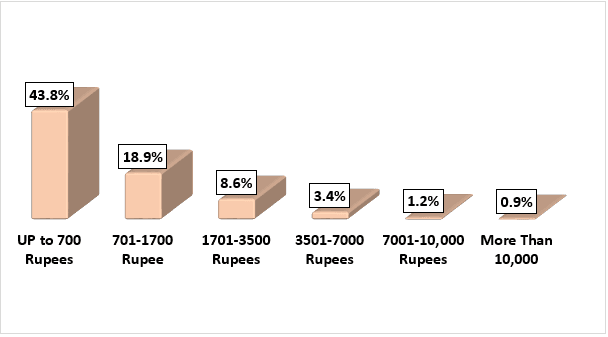
Market Engineering
The data triangulation technique was employed to complete the overall market estimation and to arrive at precise statistical numbers for each segment and sub-segment of the global diabetic retinopathy device market. data was split into several segments & sub-segments post studying various parameters and trends in the areas of the type, application, and region in the global diabetic retinopathy device market.
The main objective of the Global Diabetic Retinopathy Market Study
The current & future market trends of the global diabetic retinopathy device market were pinpointed in the study. Investors can gain strategic insights to base their discretion for investments on the qualitative and quantitative analysis performed in the study. Current and future market trends determined the overall attractiveness of the market at a regional level, providing a platform for the industrial participant to exploit the untapped market to benefit from a first-mover advantage. Other quantitative goals of the studies include:
- Analyze the current and forecast market size of the diabetic retinopathy device market in terms of value (USD). Also, analyze the current and forecast market size of different segments and sub-segments
- Segments in the study include areas of the type, application, and region
- Define and analysis of the regulatory framework for the diabetic retinopathy device industry
- Analyze the value chain involved with the presence of various intermediaries, along with analyzing customer and competitor behaviors of the industry
- Analyze the current and forecast market size of the diabetic retinopathy device market for the major region
- Major countries of regions studied in the report include Asia Pacific, Europe, North America, and the Rest of the World
- Company profiles of the diabetic retinopathy device market and the growth strategies adopted by the market players to sustain in the fast-growing market
- Deep dive regional level analysis of the industry
Frequently Asked Questions FAQs
Q1: What is the current market size and growth potential of the global diabetic retinopathy market?
Q2: What are the driving factors for the growth of the global diabetic retinopathy device Market?
Q3: Which segment has the largest share of the global diabetic retinopathy device market by type?
Q4: What are the emerging technologies and trends in the global diabetic retinopathy device market?
Q5: Which region will dominate the global diabetic retinopathy device market?
Q6: Who are the key players operating in the global diabetic retinopathy device market?
Related Reports
Customers who bought this item also bought






